mirror VOLVO V4 2002 Owners Manual
[x] Cancel search | Manufacturer: VOLVO, Model Year: 2002, Model line: V4, Model: VOLVO V4 2002Pages: 88, PDF Size: 2.34 MB
Page 6 of 88
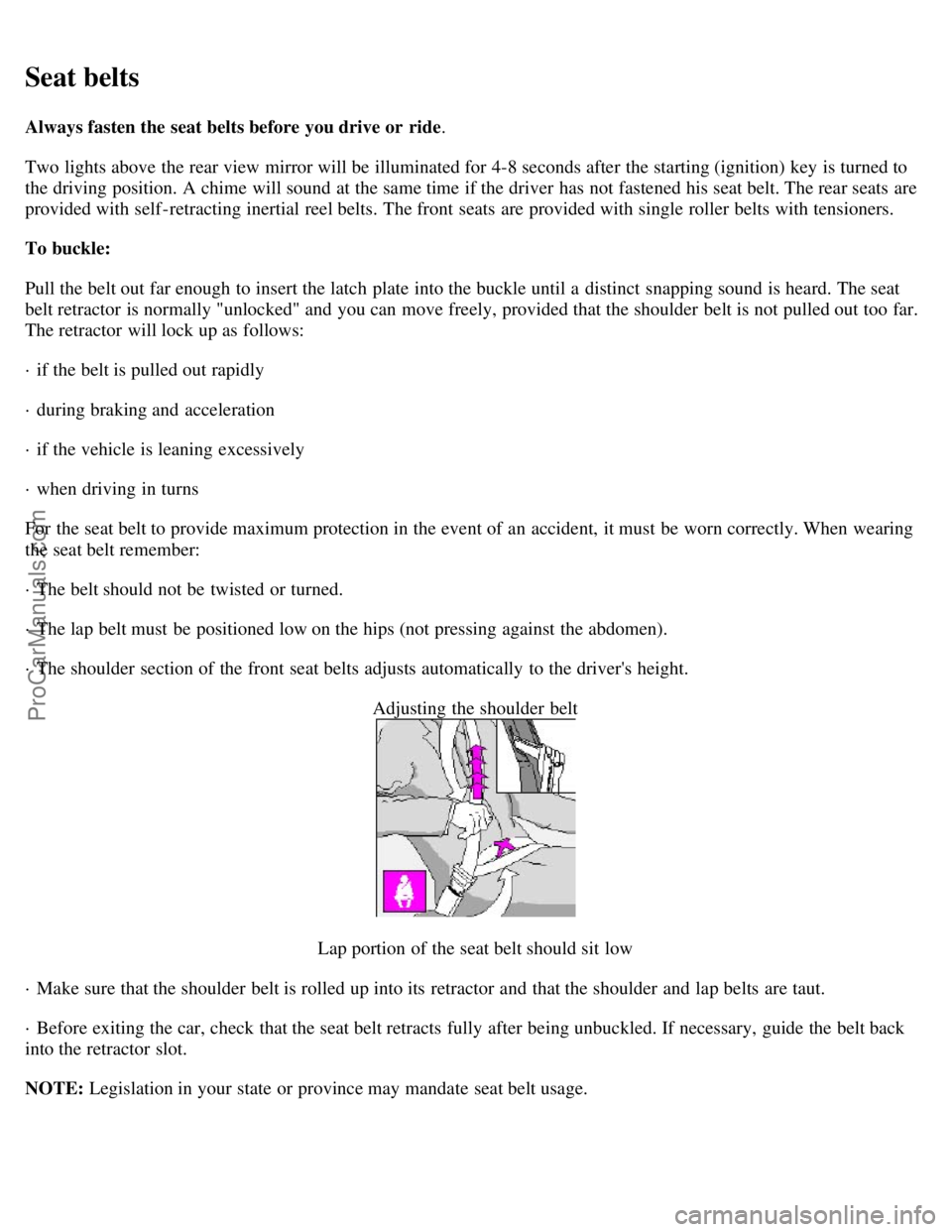
Seat belts
Always fasten the seat belts before you drive or ride.
Two lights above the rear view mirror will be illuminated for 4-8 seconds after the starting (ignition) key is turned to
the driving position. A chime will sound at the same time if the driver has not fastened his seat belt. The rear seats are
provided with self -retracting inertial reel belts. The front seats are provided with single roller belts with tensioners.
To buckle:
Pull the belt out far enough to insert the latch plate into the buckle until a distinct snapping sound is heard. The seat
belt retractor is normally "unlocked" and you can move freely, provided that the shoulder belt is not pulled out too far.
The retractor will lock up as follows:
· if the belt is pulled out rapidly
· during braking and acceleration
· if the vehicle is leaning excessively
· when driving in turns
For the seat belt to provide maximum protection in the event of an accident, it must be worn correctly. When wearing
the seat belt remember:
· The belt should not be twisted or turned.
· The lap belt must be positioned low on the hips (not pressing against the abdomen).
· The shoulder section of the front seat belts adjusts automatically to the driver's height. Adjusting the shoulder belt
Lap portion of the seat belt should sit low
· Make sure that the shoulder belt is rolled up into its retractor and that the shoulder and lap belts are taut.
· Before exiting the car, check that the seat belt retracts fully after being unbuckled. If necessary, guide the belt back
into the retractor slot.
NOTE: Legislation in your state or province may mandate seat belt usage.
ProCarManuals.com
Page 13 of 88
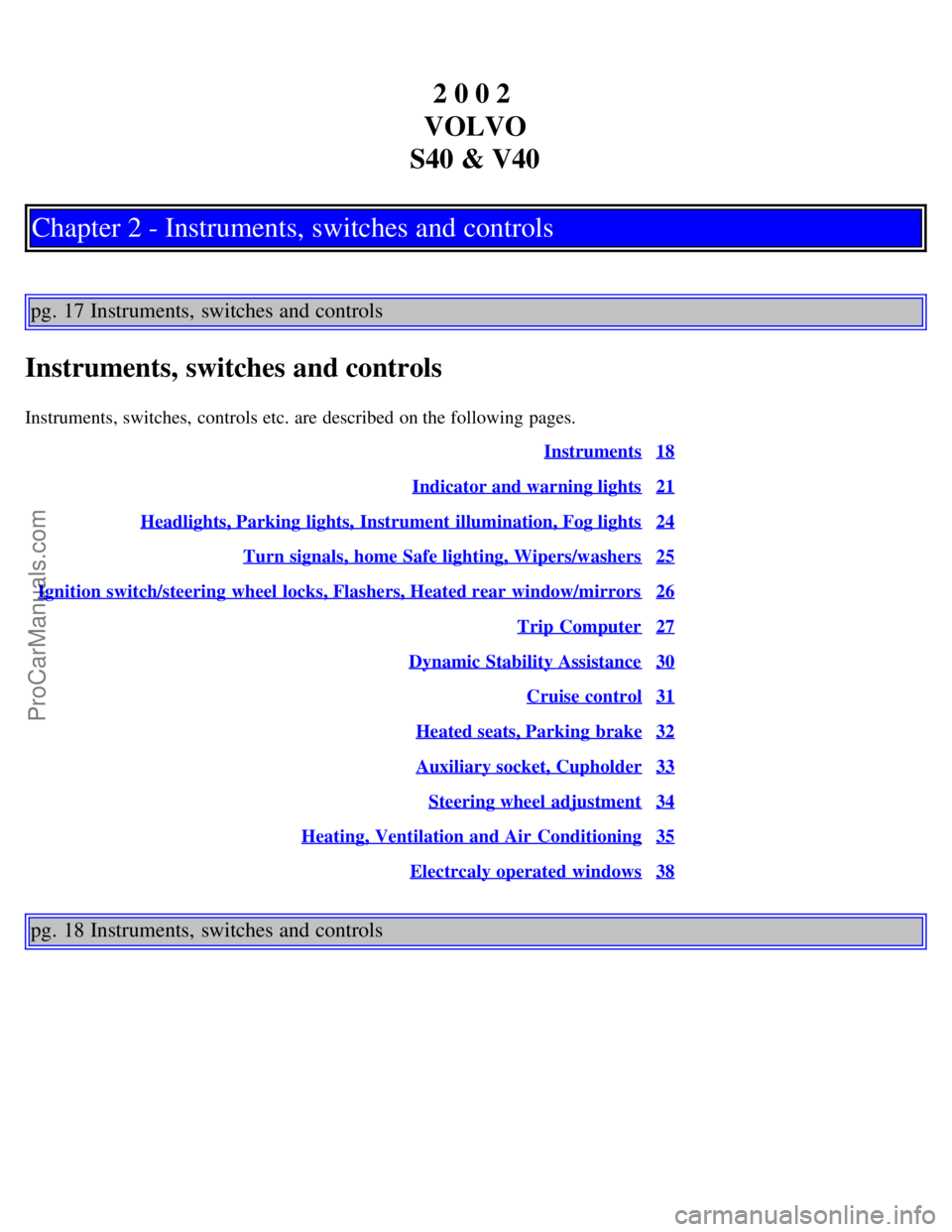
2 0 0 2
VOLVO
S40 & V40
Chapter 2 - Instruments, switches and controls
pg. 17 Instruments, switches and controls
Instruments, switches and controls
Instruments, switches, controls etc. are described on the following pages. Instruments
18
Indicator and warning lights21
Headlights, Parking lights, Instrument illumination, Fog lights24
Turn signals, home Safe lighting, Wipers/washers25
Ignition switch/steering wheel locks, Flashers, Heated rear window/mirrors26
Trip Computer27
Dynamic Stability Assistance30
Cruise control31
Heated seats, Parking brake32
Auxiliary socket, Cupholder33
Steering wheel adjustment34
Heating, Ventilation and Air Conditioning35
Electrcaly operated windows38
pg. 18 Instruments, switches and controls
ProCarManuals.com
Page 14 of 88
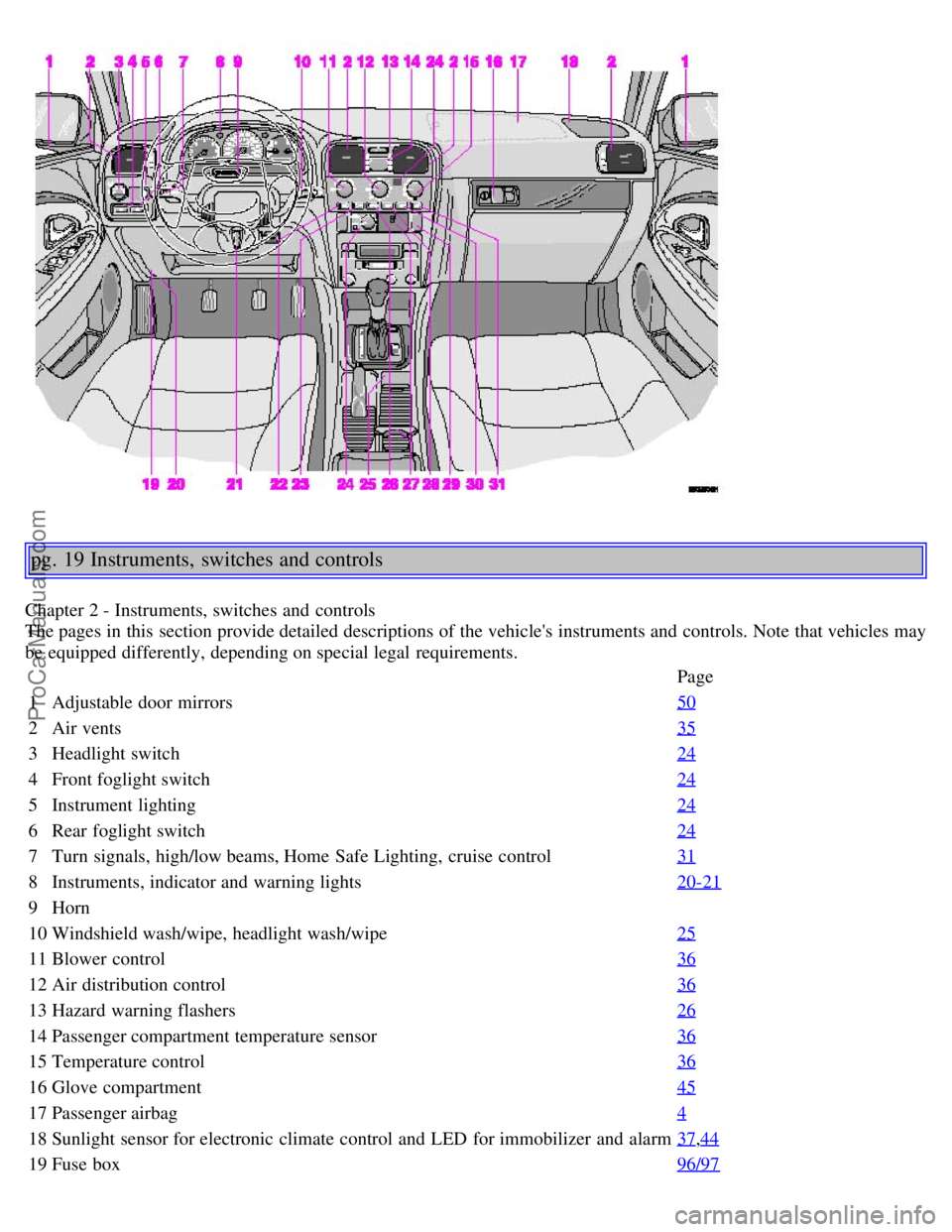
pg. 19 Instruments, switches and controls
Chapter 2 - Instruments, switches and controls
The pages in this section provide detailed descriptions of the vehicle's instruments and controls. Note that vehicles may
be equipped differently, depending on special legal requirements.Page
1 Adjustable door mirrors 50
2Air vents 35
3Headlight switch 24
4Front foglight switch 24
5Instrument lighting 24
6Rear foglight switch 24
7Turn signals, high/low beams, Home Safe Lighting, cruise control 31
8Instruments, indicator and warning lights 20-21
9Horn
10 Windshield wash/wipe, headlight wash/wipe 25
11Blower control 36
12Air distribution control 36
13Hazard warning flashers 26
14Passenger compartment temperature sensor 36
15Temperature control 36
16Glove compartment 45
17Passenger airbag 4
18Sunlight sensor for electronic climate control and LED for immobilizer and alarm 37,44
19Fuse box 96/97
ProCarManuals.com
Page 15 of 88
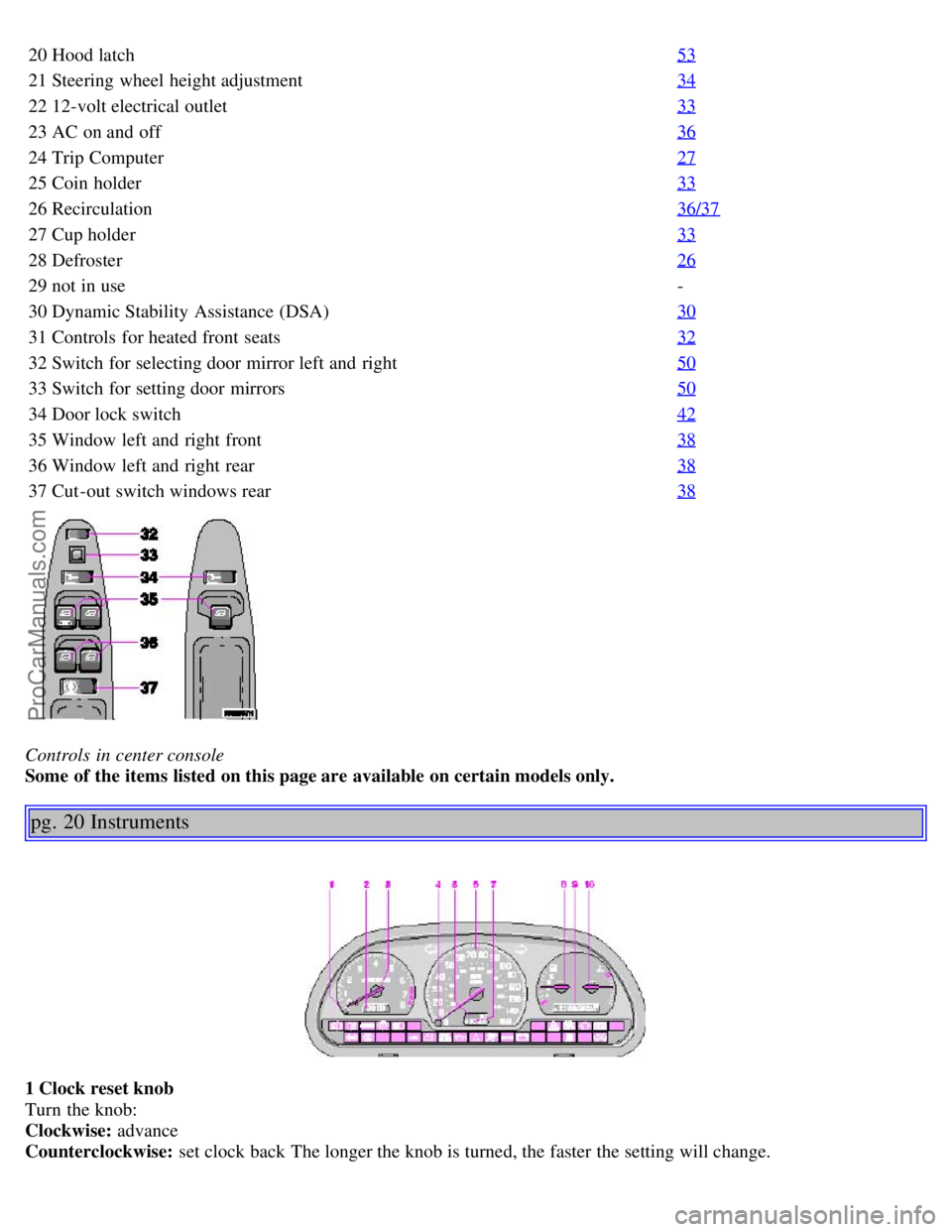
20Hood latch 53
21Steering wheel height adjustment 34
2212-volt electrical outlet 33
23AC on and off 36
24Trip Computer 27
25Coin holder 33
26Recirculation 36/37
27Cup holder 33
28Defroster 26
29not in use -
30 Dynamic Stability Assistance (DSA) 30
31Controls for heated front seats 32
32Switch for selecting door mirror left and right 50
33Switch for setting door mirrors 50
34Door lock switch 42
35Window left and right front 38
36Window left and right rear 38
37Cut -out switch windows rear 38
Controls in center console
Some of the items listed on this page are available on certain models only.
pg. 20 Instruments
1 Clock reset knob
Turn the knob:
Clockwise: advance
Counterclockwise: set clock back The longer the knob is turned, the faster the setting will change.
ProCarManuals.com
Page 23 of 88

2 0 0 2
VOLVO
S40 & V40
Chapter 3 - Body and interior
pg. 39 Body and interior
Body and interior
The seats, sun roof, mirrors, etc. are described on the following pages. Keys
40
Remote keyless entry system41
Doors and locks42
Alarm43
Trunk/Tailgate/Glove compartment45
Opening the trunk from the inside (S40)46
Front seats47
Child safety locks49
Rear/side view mirrors/Vanity mirrors50
Interior lights, Sunroof51
Sunroof52
Hood/Luggage cover53
Storage compartments54
Folding rear seat55
Securing carge56
Cargo space/Trunk light, Spare tire, Jack57
Side cargo net, Cargo net58
Weight distribution, Handling, Roadholding, Roof rack59
pg. 40 Keys
ProCarManuals.com
Page 34 of 88
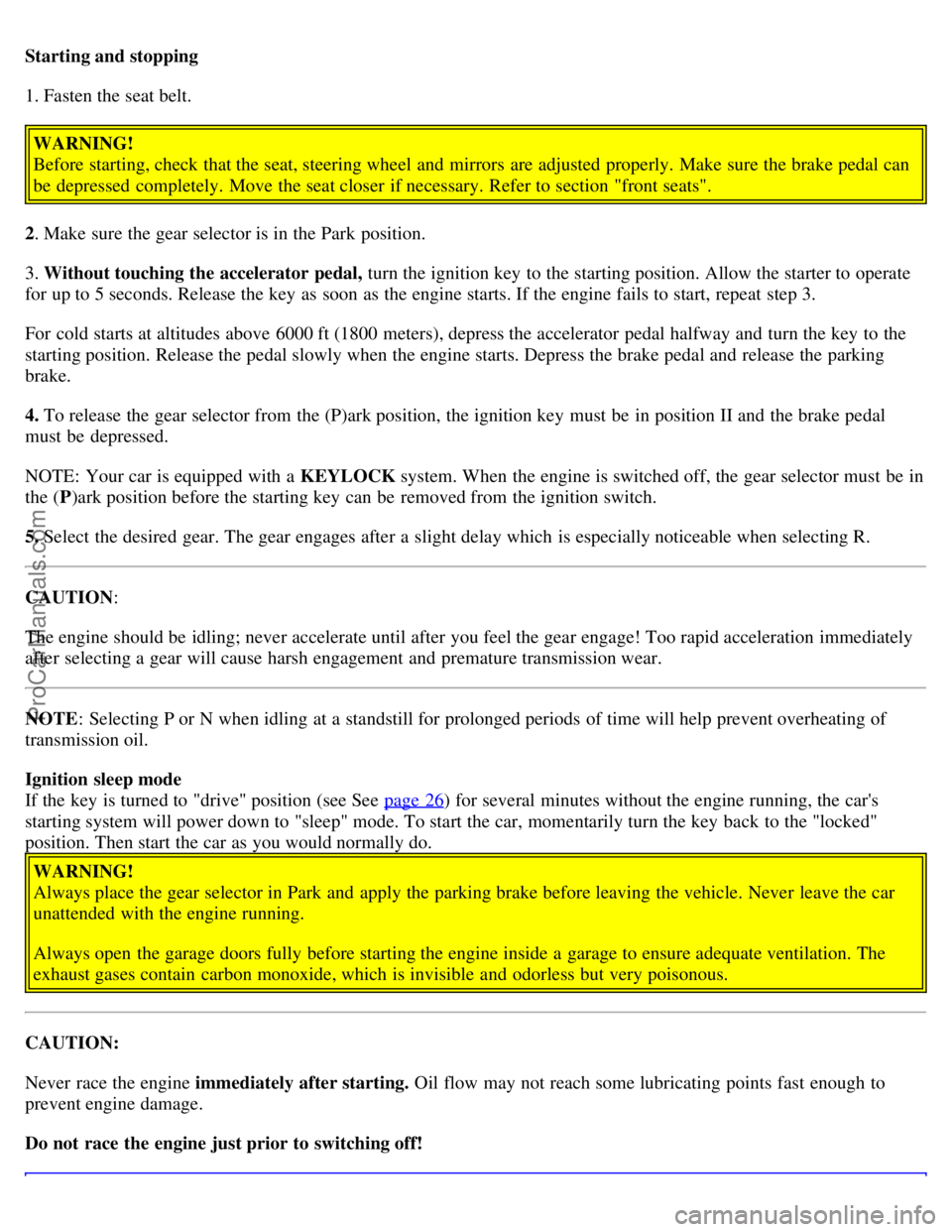
Starting and stopping
1. Fasten the seat belt.WARNING!
Before starting, check that the seat, steering wheel and mirrors are adjusted properly. Make sure the brake pedal can
be depressed completely. Move the seat closer if necessary. Refer to section "front seats".
2. Make sure the gear selector is in the Park position.
3. Without touching the accelerator pedal, turn the ignition key to the starting position. Allow the starter to operate
for up to 5 seconds. Release the key as soon as the engine starts. If the engine fails to start, repeat step 3.
For cold starts at altitudes above 6000 ft (1800 meters), depress the accelerator pedal halfway and turn the key to the
starting position. Release the pedal slowly when the engine starts. Depress the brake pedal and release the parking
brake.
4. To release the gear selector from the (P)ark position, the ignition key must be in position II and the brake pedal
must be depressed.
NOTE: Your car is equipped with a KEYLOCK system. When the engine is switched off, the gear selector must be in
the ( P)ark position before the starting key can be removed from the ignition switch.
5. Select the desired gear. The gear engages after a slight delay which is especially noticeable when selecting R.
CAUTION :
The engine should be idling; never accelerate until after you feel the gear engage! Too rapid acceleration immediately
after selecting a gear will cause harsh engagement and premature transmission wear.
NOTE : Selecting P or N when idling at a standstill for prolonged periods of time will help prevent overheating of
transmission oil.
Ignition sleep mode
If the key is turned to "drive" position (see See page 26
) for several minutes without the engine running, the car's
starting system will power down to "sleep" mode. To start the car, momentarily turn the key back to the "locked"
position. Then start the car as you would normally do.
WARNING!
Always place the gear selector in Park and apply the parking brake before leaving the vehicle. Never leave the car
unattended with the engine running.
Always open the garage doors fully before starting the engine inside a garage to ensure adequate ventilation. The
exhaust gases contain carbon monoxide, which is invisible and odorless but very poisonous.
CAUTION:
Never race the engine immediately after starting. Oil flow may not reach some lubricating points fast enough to
prevent engine damage.
Do not race the engine just prior to switching off!
ProCarManuals.com
Page 55 of 88

· Tar spots can be removed with kerosene or tar remover after the car has been washed.
· A stiff-bristle brush and lukewarm soapy water can be used to clean the wiper blades. Frequent cleaning improves
visibility considerably.
· Wash off the dirt from the underside (wheel housings fenders, etc.).
· In areas of high industrial fallout, more frequent washing is recommended.
CAUTION: During high pressure washing, the spray nozzle must never be closer to the vehicle than 13" (30 cm). Do
not spray into the locks.
· When washing or steam cleaning the engine, avoid spraying water or steam directly on the electrical components or
toward the rear side of the engine.
· After cleaning the engine, the spark plug wells should be inspected for water and blown dry if necessary.
Suitable detergents
Special car washing detergents should be used. A suitable mixture is about 2.5 fl. oz. (8.5 cl) of detergent to 2.6 US
gal. (10 liters) of warm water. After washing with a detergent the car should be well rinsed with clean water.
WARNING!
· When the car is driven immediately after being washed, apply the brakes several times in order to remove any
moisture from the brake linings.
· Engine cleaning agents should not be used when the engine is warm. This may constitute a fire risk.
NOTE: When washing the car, remember to remove dirt from the drain holes in the doors and sills. Bumpers: Wash
the bumpers with the same cleaning agent used on the rest of the car. Never clean the bumpers with gasoline or paint
thinner. Difficult spots can be removed with denatured alcohol. To avoid scratches, do not dry the bumpers with paper.
pg. 104 Automatic car washing, Polishing and waxing
Automatic washing simple and quick
Brushless car washes are recommended. An automatic wash is a simple and quick way to clean your car, but it is
worth remembering that it may not be as thorough as when you yourself go over the car with sponge and water.
Keeping the underbody clean is most important, especially in the winter. Some automatic washers do not have
facilities for washing the underbody.
Before driving into an automatic wash, make sure that side view mirrors, auxiliary lamps, etc., are secure, otherwise
there is risk of the machine dislodging them. You should also lower the antenna (sedans).
We do NOT recommend washing your car in an automatic wash during the first six months because the paint
will not have hardened sufficiently.
Polishing and waxing
Normally, polishing is not required during the first year after delivery, however, waxing is recommended.
ProCarManuals.com
Page 68 of 88
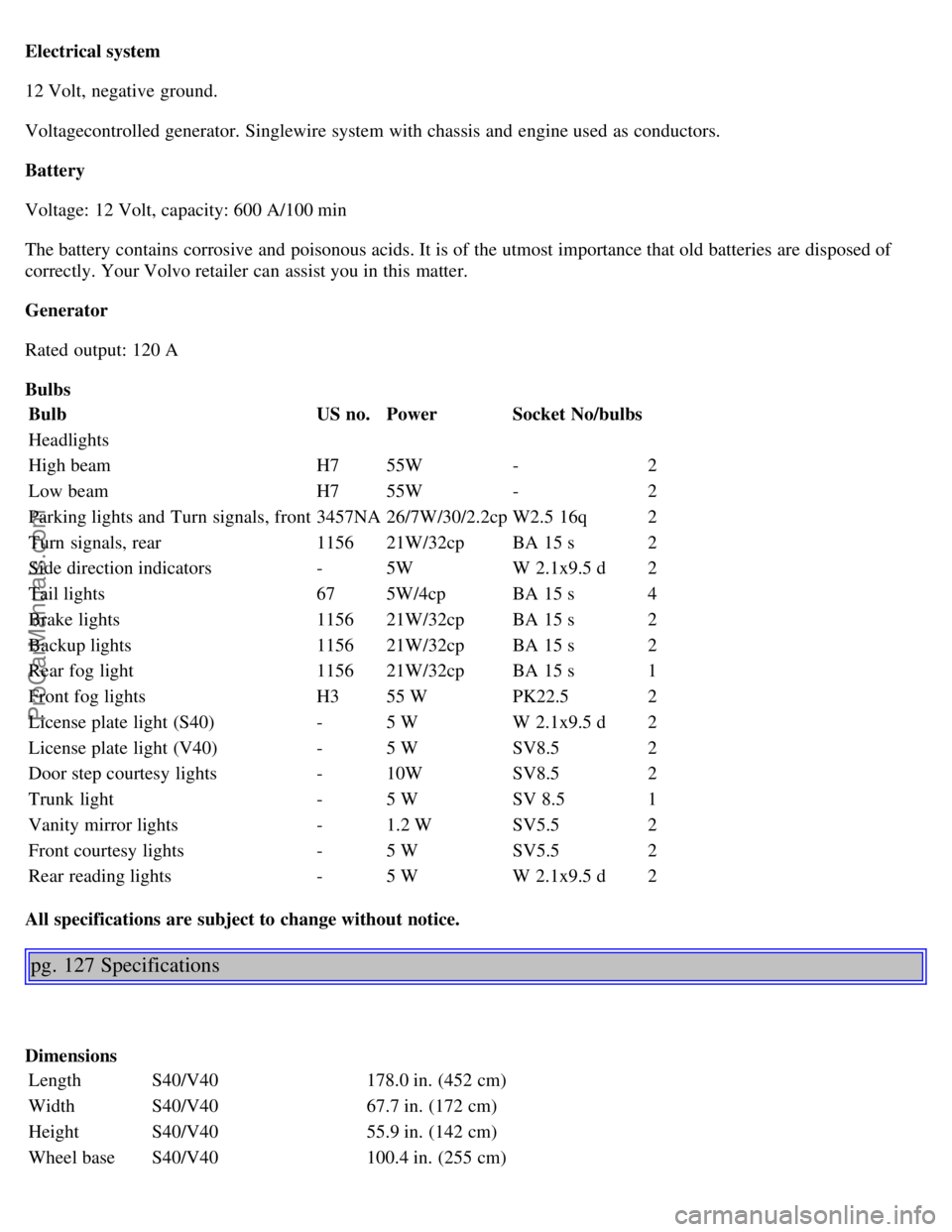
Electrical system
12 Volt, negative ground.
Voltagecontrolled generator. Singlewire system with chassis and engine used as conductors.
Battery
Voltage: 12 Volt, capacity: 600 A/100 min
The battery contains corrosive and poisonous acids. It is of the utmost importance that old batteries are disposed of
correctly. Your Volvo retailer can assist you in this matter.
Generator
Rated output: 120 A
BulbsBulb US no.Power Socket No/bulbs
Headlights
High beam H755W - 2
Low beam H755W - 2
Parking lights and Turn signals, front 3457NA26/7W/30/2.2cp W2.5 16q 2
Turn signals, rear 115621W/32cp BA 15 s 2
Side direction indicators -5W W 2.1x9.5 d 2
Tail lights 675W/4cp BA 15 s 4
Brake lights 115621W/32cp BA 15 s 2
Backup lights 115621W/32cp BA 15 s 2
Rear fog light 115621W/32cp BA 15 s 1
Front fog lights H355 W PK22.5 2
License plate light (S40) -5 W W 2.1x9.5 d 2
License plate light (V40) -5 W SV8.5 2
Door step courtesy lights -10W SV8.5 2
Trunk light -5 W SV 8.5 1
Vanity mirror lights -1.2 W SV5.5 2
Front courtesy lights -5 W SV5.5 2
Rear reading lights -5 W W 2.1x9.5 d 2
All specifications are subject to change without notice.
pg. 127 Specifications
Dimensions Length S40/V40 178.0 in. (452 cm)
Width S40/V40 67.7 in. (172 cm)
Height S40/V40 55.9 in. (142 cm)
Wheel base S40/V40 100.4 in. (255 cm)
ProCarManuals.com
Page 83 of 88

Long distance trips75
Lubrication113
Luggage strap (V40)56
Lumbar support47,48
M
Maintenance service109
Malfunction indicator lamp23
Manual transmission fluid122
Manually closing the sun roof100
Mirrors - rear/side view50
O
Occupant safety16
Octane rating63
Odometer20
Oil - engine115
Oil pressure warning light22
Opening the trunk from the inside S406
P
Paint touchup102
Parking brake32
Parking brake reminder light22
Polishing104
Power seats48
Power steering fluid116,122
PROPOSITION 65 WARNING72,119
R
Radio tuning modes - changing142
Rear fog light24
Rear suspension124
Rear waste bin34
Refueling63
Remote control (central locking system)41
Remote keyless entry system41
Replacing bulbs90, 92, 93, 94
Replacing fuses95
Replacing number plate lighting - V4094
Reporting safety defects16
Road assistance128
Roadholding59
Roof rails/racks59
S
Safety defects - reporting16
Safety locks - child49
Seat belt maintenance16
ProCarManuals.com
Page 84 of 88
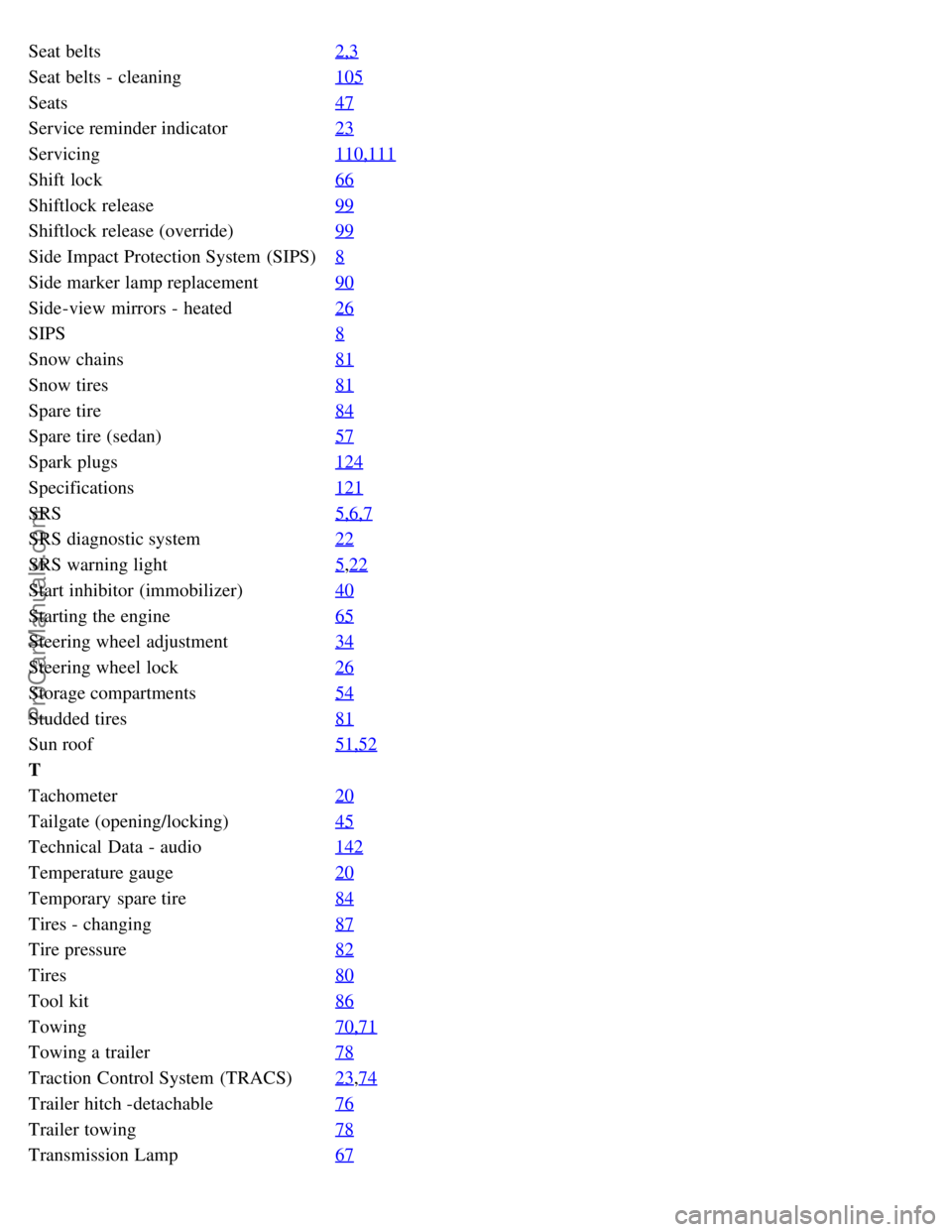
Seat belts2,3
Seat belts - cleaning105
Seats47
Service reminder indicator23
Servicing110,111
Shift lock66
Shiftlock release99
Shiftlock release (override)99
Side Impact Protection System (SIPS)8
Side marker lamp replacement90
Side-view mirrors - heated26
SIPS8
Snow chains81
Snow tires81
Spare tire84
Spare tire (sedan)57
Spark plugs124
Specifications121
SRS5,6,7
SRS diagnostic system22
SRS warning light5,22
Start inhibitor (immobilizer)40
Starting the engine65
Steering wheel adjustment34
Steering wheel lock26
Storage compartments54
Studded tires81
Sun roof51,52
T
Tachometer20
Tailgate (opening/locking)45
Technical Data - audio142
Temperature gauge20
Temporary spare tire84
Tires - changing87
Tire pressure82
Tires80
Tool kit86
Towing70,71
Towing a trailer78
Traction Control System (TRACS)23,74
Trailer hitch -detachable76
Trailer towing78
Transmission Lamp67
ProCarManuals.com